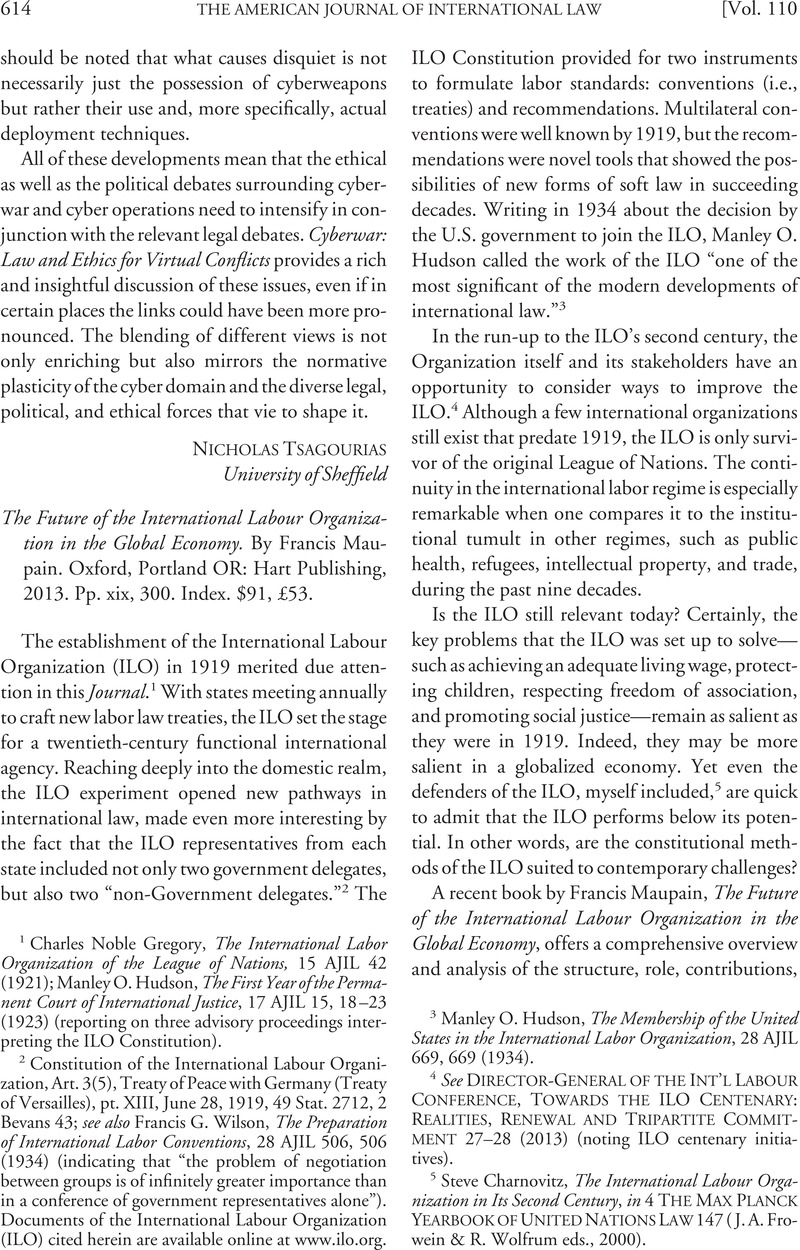No CrossRef data available.
Published online by Cambridge University Press: 20 January 2017

1 Gregory, Charles Noble, The International Labor Organization of the League of Nations, 15 AJIL 42 (1921)Google Scholar; Hudson, Manley O., The First Year of the Permanent Court of International Justice, 17 AJIL 15, 18–23 (1923)CrossRefGoogle Scholar (reporting on three advisory proceedings interpreting the ILO Constitution).
2 Constitution of the International Labour Organization, Art. 3(5), Treaty of Peace with Germany (Treaty of Versailles), pt. XIII, June 28, 1919, 49 Stat. 2712, 2 Bevans 43; see also Wilson, Francis G., The Preparation of International Labor Conventions, 28 AJIL 506, 506 (1934)CrossRefGoogle Scholar (indicating that “the problem of negotiation between groups is of infinitely greater importance than in a conference of government representatives alone”). Documents of the International Labour Organization (ILO) cited herein are available online at www.ilo.org.
3 Hudson, Manley O., The Membership of the United States in the International Labor Organization, 28 AJIL 669, 669 (1934)CrossRefGoogle Scholar.
4 See Director-General of the Int’l Labour Conference, Towards the ILO Centenary: Realities, Renewal and Tripartite Commitment 27–28 (2013) (noting ILO centenary initiatives).
5 Charnovitz, Steve, The International Labour Organization in Its Second Century, in 4 The Max Planck Yearbook of United Nations Law 147 (Frowein, J.A. & Wolfrum, R. eds., 2000)Google Scholar.
6 Book Review Symposium: The Future of the International Labour Organization in the Global Economy, by Francis Maupain, 154 Int’l Lab. Rev. 67–114 (2015).
7 ILO, Maternity Protection Convention (No. 103) (June 28, 1952).
8 ILO, Domestic Workers Convention (No. 189) (June 16, 2011).In june 2016, the ILO Conference will consider amendments to two maritime conventions.
9 ILO, Declaration on Fundamental Principles and Rights at Work (June 18, 1998).
10 Id., Art. 2.
11 See ILO, Report of the Committee on the Declaration of Principles: Submission, Discussion and Adoption (June 1998), at http://www.ilo.org/public/english/standards/relm/ilc/ilc86/com-decd.htm.
12 Maupain suggests that such an obligation might already inure for organizations attached to the United Nations (p. 112 n. 26).
13 ILO, Tripartite Declaration of Principles Concerning Multinational Enterprises and Social Policy, Nov. 16, 1977, 17 ILM 422, para. 6 (1978) (as amended by the ILO Governing Body in 2000 and 2006).
14 Director-General of the Int’l Labour Conference, Tackling The Global Jobs Crisis: Recovery Through Decent Work Policies (2009).
15 Int’l Labour Conference, Recovering from the Crisis: A Global Job Pact (2009).
16 ILO, Employment Policy Convention (No. 122) (July 9, 1964).